The Battle of Badr, fought on March 13, 624 CE, stands as one of the most significant battles in Islamic history. This clash between the nascent Muslim community of Medina and the Quraysh tribe of Mecca marked a turning point in the Prophet Muhammad’s mission, shaping the future of Islam.
The Context: From Persecution to Resistance
The early years of Islam were fraught with persecution. Muhammad and his followers faced severe hostility from the Quraysh, the dominant tribe in Mecca. The Muslims were forced to flee to Medina (then known as Yathrib) in 622 CE, an event known as the Hijra. This migration not only provided them with a safe haven but also a new base from which to spread their faith.
By 624 CE, tensions between the Meccan Quraysh and the Muslim community in Medina had escalated. The Quraysh, feeling threatened by the growing influence of Islam, sought to eliminate this burgeoning threat.
Prelude to Battle: Strategic Movements
The immediate catalyst for the Battle of Badr was a Muslim attempt to intercept a wealthy Meccan caravan led by Abu Sufyan. The caravan, returning from Syria, carried valuable goods that could significantly bolster the Muslim community’s resources. Abu Sufyan, aware of the Muslims’ intentions, sent word to Mecca, prompting the Quraysh to dispatch a formidable force to protect their caravan.
The Quraysh army, numbering around 1,000 men, was vastly superior to the Muslim contingent of approximately 313 fighters. Despite being outnumbered and less equipped, the Muslims prepared for battle, driven by a deep sense of faith and conviction in their cause.
The Battle Unfolds: Divine Intervention and Tactical Brilliance
The two armies met at the wells of Badr, southwest of Medina. The Muslims, led by the Prophet Muhammad himself, displayed remarkable strategic acumen. They secured a favorable position by controlling the wells, ensuring their access to water while denying it to their enemies.
The battle began with traditional Arab single combat. The Muslims’ champions, including Ali ibn Abi Talib and Hamza ibn Abdul-Muttalib, emerged victorious in these duels, boosting the morale of their comrades.
As the battle intensified, the Muslims fought with unwavering determination. According to Islamic tradition, they were bolstered by divine intervention, with angels said to have fought alongside them. This belief in divine support played a crucial role in maintaining the Muslims’ morale and resolve.
The Outcome: A Decisive Victory
The Battle of Badr concluded with a resounding victory for the Muslims. Despite their numerical disadvantage, they managed to kill around 70 Quraysh warriors, including several of their leaders, and capture another 70. The Muslim casualties were relatively light, with about 14 martyrs.
This victory had profound implications. It significantly boosted the morale of the Muslim community, establishing their presence as a formidable force in the Arabian Peninsula. The defeat demoralized the Quraysh and shattered their aura of invincibility.
Aftermath and Legacy
The Battle of Badr was more than just a military triumph; it was a validation of the Muslims’ faith and a testament to their resilience. It marked the beginning of a series of confrontations between the Muslims and the Quraysh, eventually leading to the conquest of Mecca in 630 CE.
The battle also had lasting religious and political significance. It demonstrated the importance of faith, unity, and strategic planning in achieving seemingly insurmountable goals. For Muslims, Badr is a symbol of divine support and the triumph of truth over falsehood.
Conclusion: A Turning Point in History
The Battle of Badr remains a pivotal moment in Islamic history, celebrated annually on the 17th of Ramadan. It serves as a reminder of the struggles faced by the early Muslims and their unwavering commitment to their faith. The lessons of Badr continue to inspire Muslims around the world, embodying the spirit of resilience, courage, and divine faith.
In the broader historical context, Badr is a testament to how a small, determined group can change the course of history, leaving an indelible mark on the world.

